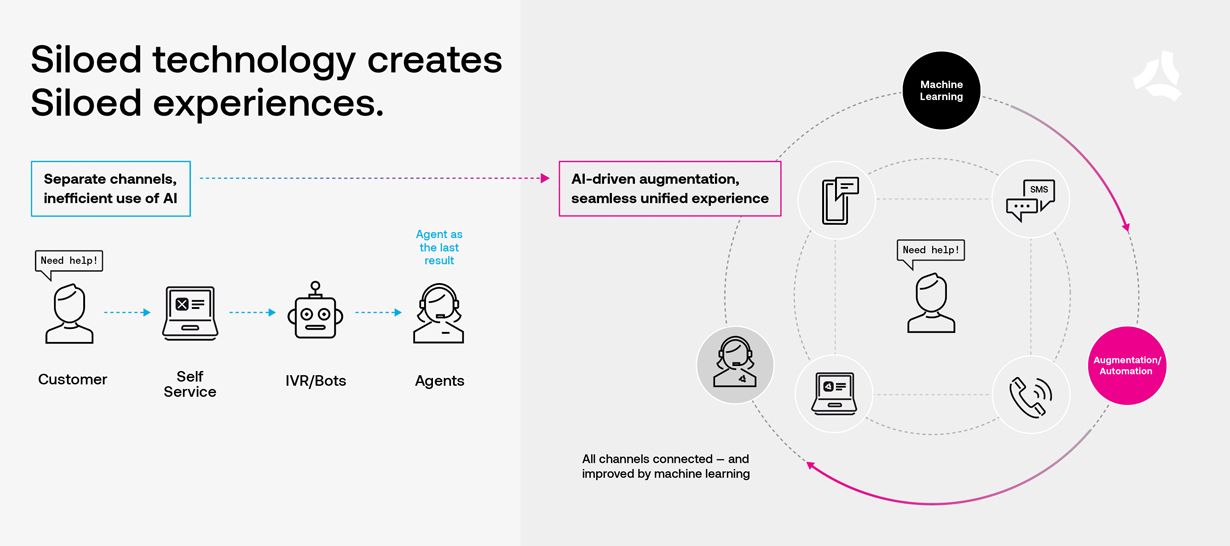Austin Meyer

Austin Meyer is the Head of Solution Design at ASAPP and leads a team of solution engineers and consultants to provide thought leadership and technical guidance to enterprises that have prioritized digital channels and agent augmentation as the foundation for future growth and customer engagement.
Prior to ASAPP, Austin led solution teams at Cambridge Semantics to apply the latest in graph and semantic technology in order to solve some of the world’s most complex data integration challenges critical to business intelligence and machine learning initiatives. His broad experience across the data value chain has given him a balanced perspective on how to make significant and continual impact at large organizations when it comes to embracing digitization and unlocking the potential of data.
Automation should help resolve, not deflect



The mission of Solution Design at ASAPP is to help companies identify areas of massive opportunity when it comes to optimizing their contact centers and digital customer experiences. At the highest level, we aim to help our customers provide an extremely personalized and proactive experience at a very low cost by leveraging machine learning and AI. While we’ve seen many different cost saving and personalization strategies when it comes to the contact center, the most common by far is as follows:
- Step 1:
Leverage self service channels (website, mobile apps, etc) built by digital teams and hope customers resolve issues themselves or buy products directly. - Step 2:
If customers aren’t able to solve issues on their own, offer “assistance” using an IVR or chatbot, with the goal of preventing customers from talking to an agent. - Step 3:
When these fail, because the question is too complex or there isn’t an easy way to self serve, have an agent handle it as quickly as possible, often starting from scratch.
It’s a strategy that many Fortune 500 companies were convinced would revolutionize the customer experience and bring about significant cost savings. Excited by the promises of chatbot and IVR companies who said they could automate 80% of interactions within a year—which they assumed would reduce the need for agents to handle routine tasks– companies spent millions of dollars on these technologies.
Automation as you know it isn’t working
While some are seeing high containment numbers put forth in business cases, the expected savings haven’t materialized—as evidenced by how much these companies continue to spend on customer service year after year. Furthermore, customers are frustrated by this strategy—with most people (myself included) asking repeatedly for an agent once they interact with an IVR or bot. The fact is, people are calling in about more complex topics, which require knowledgeable and empathetic people on the other end of the line.

We live in a new era where the companies who can provide extremely efficient and personalized interactions at a lower cost than their competitors are winning out.
Austin Meyer
It’s not surprising that in 2019, executive mentions of chatbots in earnings calls dropped dramatically and chatbot companies struggled to get past seed rounds of investment (cite). These programs cost millions of dollars in software and tooling, and double or triple that for the labor involved with building, maintaining, measuring, and updating logic flows. Beyond NOT increasing contact center efficiency, chatbot technology has reduced customer satisfaction, impeded sales conversion, and has caused the market to missassociate AI with automate everything or nothing.
A better automation strategy
We live in a new era where the companies who can provide extremely efficient and personalized interactions at a lower cost than their competitors are winning out.
There has been a retreat from using bot automation to avoid customer contact. Instead, leading companies are using ML and AI to improve digital customer experiences while simultaneously helping agents become more efficient. Furthermore, by connecting the cross channel experiences and using machine learning across them, conversational data is much more complete and more valuable to the business.
Compared to the earlier strategy, where there were distinct walls between self service, automation and agents, this new strategy looks far more blended. Notice that automation doesn’t stand alone—instead, it’s integrated with the customer experience AND agent workflows. Machine learning provides efficiency gains by enabling automation whenever appropriate, leading to faster resolution regardless of channel.

At ASAPP, we use AI-driven agent augmentation and automation to improve customer experience and increase contact center efficiency. The results have been transformative—saving our customers millions of dollars in opex, generating millions in additional revenue while dramatically improving CSAT/NPS and digital engagement. If you want to learn more about our research, results, or strategy reach out to me at solutions@asapp.com.
Why a little increase in transcription accuracy is such a big deal



A lot has been written lately about the importance of accuracy in speech-to-text transcription. It’s the key to unlocking value from the phone calls between your agents and your customers. For technology evaluators, it’s increasingly difficult to cut through the accuracy rates being marketed by vendors—from the larger players like Google and Amazon to smaller niche providers. How do you determine the best transcription engine for your organization to unlock the value of transcription?
The reality is that there is no one speech transcription model to rule them all. How do we know? We tried them.
In our own testing some models performed extremely well in industry benchmarks. But then they failed to reproduce even close to the same results when put into production contact center environments.
Benchmarks like Librispeech use a standardized set of audio files which speech engineers optimize for on many different dimensions (vocabulary, audio type, accents, etc). This is why we see WERs in the <2% range. These models are now outperforming the human ear (4% WER) on the same data which is an incredible feat of engineering. Doing well on industry benchmarks is impressive—but what evaluators really need to know is how these models perform in their real-world environment.
What we’ve found in our own testing is that most off-the-shelf Automatic Speech Recognition (ASR) models struggle with different contact center telephony environments and the business specific terminology used within those conversations. Before ASAPP, many of our customers were able to get transcription live after months of integration and even utilized domain specific ASRs, but only saw accuracy rates in the area of 70%, nudging closer to 80% only in the most ideal conditions. That is certainly a notch above where it was 5 or 10 years ago, but most companies still don’t transcribe 100% of phone calls. Why? Because they don’t expect to get enough value to justify the cost.
So how much value is there in a higher real-world accuracy rate?

The words that are missed in the gap between 80% accuracy and 90% accuracy are often the ones that matter most. They’re the words that are specific to the business and are critical to unlocking value.
Austin Meyer
More than you might imagine. Words that are missed are often the most important ones—specific to the business and are critical to unlocking value. These would be things like:
- Company names (AT&T, Asurion, Airbnb)
- Product and promotion names (Galaxy S12, MLB League Pass, Marriott Bonvoy Card)
- People’s names, emails and addresses
- Long numbers such as serial numbers and account numbers
- Dollar amounts and and dates
To illustrate this point, let’s look at a sample of 10,000 hours of transcribed audio from a typical contact center. There are roughly 30,000 unique words within those transcripts, yet the system only needs to recognize 241 of the most frequently used words to get 80% accuracy. Those are largely words like “the”, “you”, “to”, “what”, and so on.
To get to 90% accuracy, the system needs to correctly transcribe the next 324 most frequently used words, and even more for every additional percent. These are often words that are unique to your business—the words that really matter.

Context also impacts accuracy and meaning. If someone says, “Which Galaxy is that?”, depending on the context, they could be talking about a Samsung phone or a collection of stars and planets. This context will often impact the spelling and capitalization of many important words.
Taking this even further, if someone says, “my Galaxy is broken”, but they don’t mention which model they have, anyone analyzing those transcripts to determine which phone models are problematic won’t know unless that transcript is tied to additional data about that customer. The effort of manuallying integrating transcripts to other datasets that contain important context dramatically increases the cost of getting value from transcription.
When accuracy doesn’t rise above 80% in production and critical context is missing, you get limited value from your data– nothing more than simple analytics like high level topic/intent categorization, maybe tone, basic keywords, and questionable sentiment scores. That’s not enough to significantly impact the customer experience or the bottom line.
It’s no wonder companies can’t justify transcribing 100% of their calls despite the fact that many of them know there is rich data there.
The key to mining the rich data that’s available in your customer conversations—and to getting real value from transcribing every word of every call is threefold:
- Make sure you have an ASR model that’s custom tuned and continuously adapts to the lexicon of your business.
- Connect your transcripts to as much contextual metadata as possible.
- Have readily accessible tools to analyze data and act on insights in ways that create significant impact for your business—both immediately and long term.
ASAPP answers that call. When you work with us you’ll get a custom ASR model trained on your data to transcribe conversation in real time, and improve with every call. Our AI-driven platform will deliver immediate business value through an array of CX-focused capabilities, fed by customer conversations and relevant data from other systems. Plus, it provides a wealth of voice of the customer data that can be used across your business. When you see your model in action and the tremendous value you get with our platform, it makes a lot more sense to transcribe every word of every call. Interested? Send us a note at ask@asapp.com and we’ll be happy to show you how it’s done.









.png)








